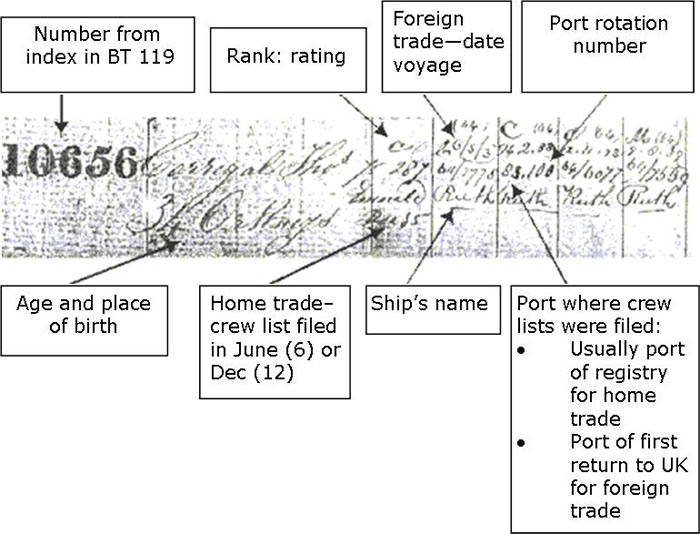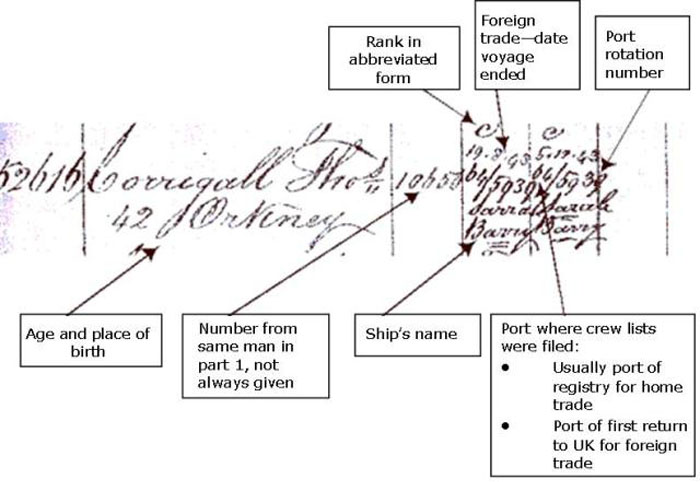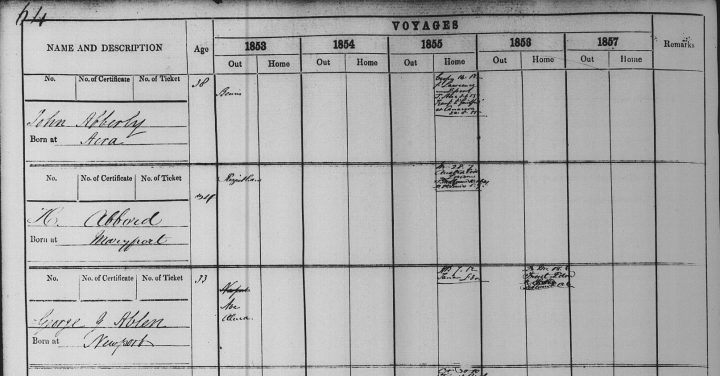
How to look for records of... Merchant Navy seamen in service before 1914
How can I view the records covered in this guide?
How many are online?
- Some
This is a guide to finding records of merchant seamen in service before the start of the First World War. Before 1835, central government took little interest in keeping records of individual seafarers, so most of the records covered in this guide date from between 1835 and 1913. For details of seamen in employment before 1835 your best bet is to consult muster rolls or to look elsewhere, perhaps in private collections or old newspapers.
If you are looking for a record of a merchant officer, read our guide on Officers in the Merchant Navy.
What do I need to know before I start?
The black hole in the records: 1858-1913
Between 1858 and the First World War the Merchant Navy did not keep registers of its seamen. This means that for these years the only record you are likely to find of an individual merchant seaman is his appearance in agreements and crew lists, for which you usually need to know the names of the ships he served on.
How to trace a ship
Sometimes the only way to track down a record of a seaman is to trace the records of the ships he served on. You can use the CLIP (Crew List Index Project) website to trace a ship by the:
- ship’s name
- ship’s port of registration
- ship’s official number
There is more advice on finding crew lists and agreements, 1861-1938 in our more in-depth guide to these records.
How to interpret abbreviations in the records
See our guide to Abbreviations in merchant seamen records for further help interpreting information in these records.
Online records
Registers of seamen, 1835-1857
From 1835, the new Register Office of Merchant Seamen (later the Registrar General of Shipping and Seamen) recorded details of seamen in registers. The information came from the agreements and crew lists submitted by the masters of ships at the end of one or a series of voyages.
Search by name in the registers of merchant seamen from 1835 to 1857 at Findmypast.co.uk (£). You may find more than one record for a single seaman, depending on his years of service. These are digitised copies of the following National Archives collections:
- Register of Seamen Series I, 1835-1836 – the originals are in series BT 120.
- Register of Seamen Series II, 1835-1844 – the originals are in series BT 112 (a name index to which is in BT 119). See Appendix 2 for an example of a typical register entry from 1835-1840 and Appendix 3 for an example from 1842-1844.
- Register of Seamen’s Tickets, 1845-1854 – the originals are in series BT 113 (a surname index to which is in BT 114 – though any ticket numbers above 546,00 in the indexes do not appear in the registers). See Appendix 4 for an example of a typical register entry from 1845-1854. There do not seem to be any ‘reported voyages’ in BT 113 for the years 1849, 1850 and 1854.
- Register of Seamen Series III, 1853-1857 – the originals are in series BT 116. See Appendix 5 for an example of a typical register entry from 1853-1857.
The records typically include:
- First and last name
- Age or date of birth (BT 112 gives both)
- Place of birth
- Rank/rating/role (not BT 116)
- Dates of voyages (see Appendix 1 for advice on how to interpret information on voyages)
- Physical appearance (BT 113 only)
- Ships’ names
- Dates and ports of departure (BT 116)
- Port of ships’ registry
- notes on why the seamen left the vessel and where he went (‘how disposed of’)
Merchant Navy apprenticeship records, 1824-1910
Merchant Navy apprentices served their apprenticeship under the terms of an indenture (contract) which usually stipulated a term of four or five years working for a particular master. We hold a sample of these indentures and the original indexes which were used to keep track of them are available online. Search the indexes of Merchant Navy apprentice indentures between 1824 and 1910 (BT 150/1-53) on Ancestry (£). The indexes usually indicate:
- Name and age of the apprentice
- The term of their indenture
- The date their indenture began
- The master to whom they were indentured
- The name and port of registry of the vessel on which they began their apprenticeship
The indentures themselves are in BT 151 and BT 152 but provide little more than the indexes themselves contain. Furthermore, only a sample of these original indentures survive – for more information see Merchant Navy apprenticeship indentures, 1824-1953 below.
Register of duties paid for apprentices’ indentures, 1710-1811
Search the register of duties paid for apprentices’ indentures on Ancestry (£). These records of apprenticeships, from IR 1, are for various professions, including seamen both as apprentices and as masters.
Records available only at The National Archives in Kew
To access these records you will either need to visit us, pay for research (£) or, where you can identify a specific record reference, order a copy (£).
Ships’ muster rolls, 1747-1834
From 1747 masters or owners of merchant ships were required to keep a muster roll giving details of the number of crewmen and the ship’s voyages.
Ships’ muster rolls, recording very brief details of crew, survive for a few ports only:
- Shields and other northern ports from 1747
- Plymouth from 1761
- Dartmouth from 1770
- Liverpool from 1772
- other ports from 1800
Search the muster rolls in BT 98 by date range and port of registry:
We provide more advice on finding muster rolls in our guide to these records.
Agreements and crew lists, 1835-1860
In 1835, following the Merchant Shipping Act, muster books were replaced by similar records known as ‘agreements and crew lists’.
You can search for crew lists and agreements by ships’ port of registry (1835-1844), alphabetical ranges of ships’ names (1845-1856) or numerical ranges of ships’ numbers (1857-1860) in BT 98.
There is more advice on finding crew lists and agreements in our more in-depth guide to these records.
Agreements and crew lists, 1861-1938
The National Archives holds a 10% sample of agreements and crew lists for 1861 to 1938, held in record series BT 99.
Search the agreements and crew lists in BT 99 by the ship’s official number for the period 1861 to 1938. For the years 1881 and 1891 only you can search by official number, ship’s name or name of crewman.
There is more advice on finding crew lists and agreements, 1861-1938 in our more in-depth guide to these records.
Merchant Navy apprenticeship indentures, 1824-1955
Merchant Navy apprentices served their apprenticeship under the terms of an indenture (contract) which usually stipulated a term of four or five years working for a particular master. We hold a sample of these indentures – a two month sample for every five years between 1824 and 1955.
Search for copies of these indentures in BT 151 (all vessels) and BT 152 (fishing boats only) by date and port. There are original indexes to these records in BT 150, available online for the years 1824-1910 (see ‘Online records’ section above). The indentures provide more or less the same information as the indexes and if you have seen an index entry you are unlikely to gain any additional insights form the indenture itself – though they do contain the signatures of the apprentice and master.
Records in other archives and organisations
Agreements and crew lists, 1861-1994
Most agreements and crew lists for this period are held in repositories other than The National Archives. Search at the following:
- Maritime History Archive in Newfoundland holds approximately 70% of the crew lists and agreements for the years 1861-1938 and 1951-1976. You can search these by ship’s official number.
- National Maritime Museum in London holds 10% of agreements and crew lists for the periods 1861-1938 and 1951-1976. In general, the records held are for years ending with five (1865, 1875, and so on) however they do hold some other years too. Contact them directly to find out more.
- National Records of Scotland
- National Archives of Ireland
Other resources
Websites
Search the Apprentices of Great Britain 1710-1774 database on Findmypast.co.uk (£) for indexes to apprenticeships in IR 1.
Consult the Crew List Index Project (CLIP) website, which has information about merchant seamen on British registered ships from 1861 to 1913.
Books
Search The National Archives’ shop to see whether any of the publications below may be available to buy. Alternatively, look in The National Archives’ library catalogue to see what is available to consult at Kew.
Christopher and Michael Watts, My Ancestor was a Merchant Seaman (Society of Genealogists, 2002)
Appendix 1: Interpreting voyage details
Details of the voyages a seaman took are recorded in most of the registers. Some are ‘home trade’ voyages (ships sailing in waters around Britain) and others are ‘foreign trade’ voyages (ships sailing further afield).
‘Home trade’ voyages
Where home trade voyages are recorded in the registers, entries do not simply record a single voyage, but a half year (January to June or July to December) during which the seaman was engaged on a particular ship.
During that period the ship may have been on several voyages. The seaman may have been engaged for some or all of the period.
‘Foreign trade’ voyages
Foreign trade voyage entries record a single voyage during which the seaman was engaged on a particular ship. There may be dates for both leaving the UK (expressed as ‘out’) and for returning to the UK (expressed as ‘home’).
A seaman may have left the UK on one ship and returned on another. Equally, the ship may have departed in one year and returned in the next.
Appendix 2: Example of a register entry 1835-1840 (BT 112)
The registers are of two types. The entries in the earlier registers, part 1 1835-1840 (first image) look slightly different in layout to those from the later period 1842-1844 (second image).

Register of Seamen, Series II, BT 112
Appendix 3: Example of a register entry 1842-1844 (BT 112)

Image of Register of Seamen, Series II, BT 112 part 2
Appendix 4: Example of a register entry 1845-1854 (BT 113)

Image of Register of Seamen’s Tickets, BT 113
Appendix 5: Example of a register entry 1853-1857 (BT 116)

Register of Seamen, Series III, BT 116. Document reference: BT 116/1